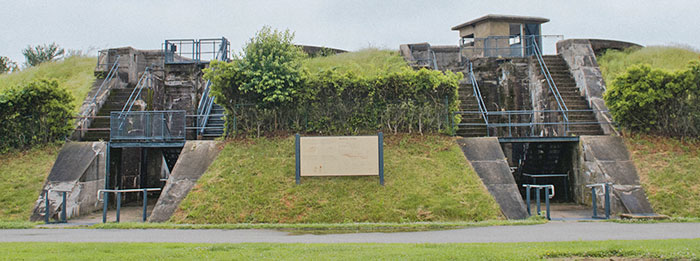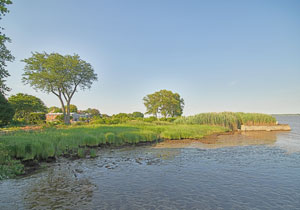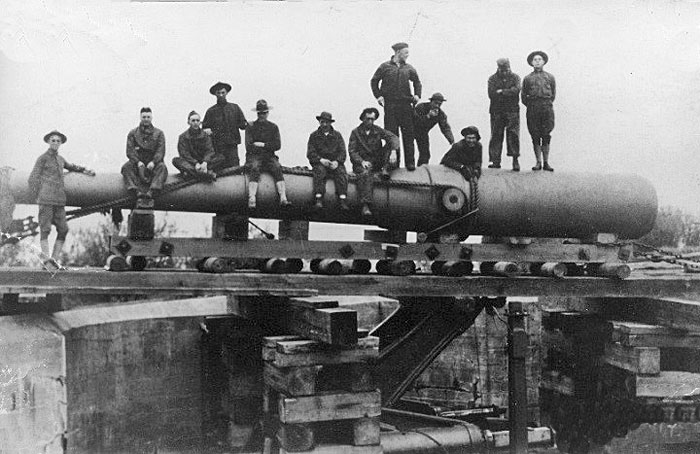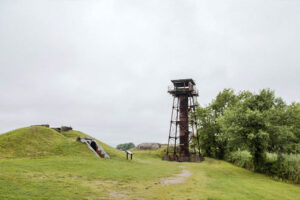Fort Mott, located in Pennsville, New Jersey, was part of the Harbor Defenses of the Delaware River.
This was a three-fort defense system designed for the Delaware River during the postbellum and Endicott program modernization periods following the Civil War and in the 1890s. The other two forts in the system were Fort Delaware on Pea Patch Island and Fort DuPont in Delaware City, Delaware.
The land where Fort Mott would be built was purchased in the 1830s by the United States government as the future site of a fortification. With advancements in military technology made during and after the Civil War, the United States’ defenses were dangerously inadequate.
The original plans for Fort Mott, initially called the “Battery at Finn’s Point,” specified eleven gun emplacements for Rodman smoothbore guns and a mortar battery with six emplacements. Construction was started in 1872; however, only two gun emplacements and two magazines in the mortar battery were completed by 1876, when all work stopped due to a general suspension of fort work.
In 1885, President Grover Cleveland, at the request of Congress, appointed the Board of Fortifications, often called the Endicott Board, and recommended a comprehensive program of new fortifications. The main defensive concept for the Delaware River was the dispersion of armaments into three separate fortifications: a new fortification in New Jersey, a new fortification in Delaware that would be called Fort DuPont, and upgrades to the existing fortification of Fort Delaware on Pea Patch Island located between New Jersey and Delaware in the middle of the Delaware River.
The original plan for the Battery at Finn’s Point was abandoned, and construction of new fortifications began in 1896. Large caliber weapons, three 10-inch and three 12-inch guns were installed on disappearing carriages. These guns had an effective range of seven to eight miles and shot projectiles that weighed 600 and 1,000 pounds, respectively. Two batteries, each with 5-inch rapid-fire guns and one battery with two 3-inch rapid-fire guns, were also part of the defenses. This fortification was officially renamed Fort Mott on December 16, 1897, to honor Major General Gershom Mott, a decorated veteran of the Mexican-American and Civil Wars.
When completed in 1902, Fort Mott contained cutting-edge military technology.
Unusual for U.S. coast defense forts built between 1895 and 1935, Fort Mott was designed to resist a land attack. Earthen embankments and a moat were placed behind the gun batteries to impede an assault from the landward side. The fort’s four 5-inch guns were in mounts permitting 360° of fire and were sited to fire on attackers flanking the embankments.
The fort had a typical armament for its day, with a few exceptions. The main armament was Battery Arnold with three 2-inch guns and Battery Harker with three 10-inch guns. These were on disappearing carriages to allow the guns to normally remain hidden from observation from the river. Flanking these were Battery Gregg, with two 5-inch M1900 guns, and Battery Krayenbuhl, with two 5-inch M1897 guns, each with all-around fire. Battery Krayenbuhl was sited atop the fort’s smallest and most unusual battery, Battery Edwards, with two 3-inch mine defense guns in large casemates rebuilt from earlier 1872 magazines. These casemated light guns, intended to protect an underwater minefield in the river by driving off minesweepers, were a unique installation in U.S. forts of this era.
Fort Mott was a self-contained military community. The post had over 30 buildings, including two large men’s barracks, non-commissioned and officer’s housing, a hospital, a post exchange, a library, a guard house, a stable, a YMCA, and a school for the soldiers’ children. Most of the buildings were constructed between 1897 and 1905.
The Delaware River served as the central transportation infrastructure for the fort, with munitions, supplies, and construction materials arriving by barge.
Sports activities were an important part of life for a soldier stationed at Fort Mott. Over the years, Fort Mott hosted baseball teams, a football team, and a basketball team; for officers, there was a clay tennis court. While off duty, the soldiers would hunt in the local marshes for waterfowl and muskrats.
For married soldiers and officers, limited housing was available on the post, with additional options located just off the post on Fort Mott Road. Some of these houses still exist on the northern side of the Parade Ground and on private property nearby. Most families of army personnel stationed at Fort Mott led a quiet and secluded life. Many of the families tended gardens and kept livestock to pass the time. The nearby towns of Salem and Delaware City also provided an escape from life on the army post.
In 1910 the two five-inch guns of Battery Gregg were transferred to Fort Ruger, Hawaii, and in 1918 the similar guns of Battery Krayenbuhl were removed for possible service as field guns on the Western Front. In 1920 the unique Battery Edwards was disarmed as part of a general removal from service of the 3-inch gun M1898.
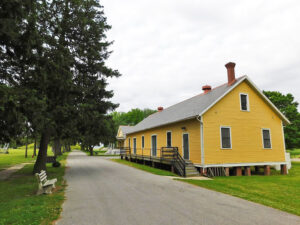
Fort Mott, New Jersey building by Jimmy Emerson/Flickr.
The two 5″ guns in Battery Krayenbuhl were removed in Nov 1917 and eventually found their way to France in 1918. Both of the guns from Battery Krayenbuhl were returned to the United States in 1919, but they were not sent back to Battery Krayenbuhl, and replacements were not furnished. The two 3″ guns from Battery Edwards were removed in 1920.
Troops were regularly stationed at Fort Mott from 1897 to 1922. Shortly before World War I, the technology at Fort Mott was deemed obsolete with the construction of Fort Saulsbury near Milford, Delaware. Fort Saulsbury had four 12-inch guns on long-range carriages and was sited to engage the enemy further down the coast than the earlier forts.
From 1922 to 1943, the federal government only maintained a caretaking detachment at the Fort. The officers’ quarters were removed in May 1933 and floated over to Fort DuPont.
Towards the end of that period, Fort Mott’s guns were dismantled and moved to other locations or cut up for scrap. Fort Mott was declared “surplus property” in 1943, and the barracks buildings and the hospital were dismantled. As with most post-Civil War U.S. coastal fortifications outside the Philippines, Fort Mott’s guns were fired only for training and testing, never in battle.
New Jersey acquired the military reservation as a historic site and State park in 1947. Fort Mott State Park was opened to the public on June 24, 1951. The New Jersey Division of Parks and Forestry operates and maintains the site.
Fort Mott and Finn’s Point National Cemetery were listed together on the National Register of Historic Places on August 31, 1978.
Today, visitors can wander through the old gun batteries, following interpretive signs with detailed descriptions. The park museum displays Fort Mott’s historical place and the technology used to defend the river. No mounted period guns or carriages remain, but the museum maintains an interesting gun yard. The batteries are well-kept and interpreted. Two fire control towers still stand on the post. A 1903 Guardhouse building, a 1902 Headquarters/Administration building, a 1901 Ordnance building, and the 1904 Peace Magazine have been restored. The ordnance building contains park offices and the museum. The Delaware River is just beyond the fortifications, with a shoreline that offers good spots for walking and picnicking.
Fort Mott State Park is on the Delaware River in Pennsville, New Jersey.
© Kathy Alexander/Legends of America, updated January 2023.
Also See:
Sources:
Fort Wiki
Fort Mott State Park
New Jersey State Park Service
Wikipedia

